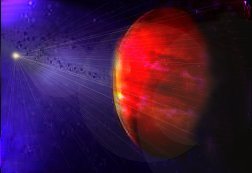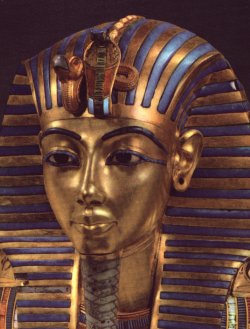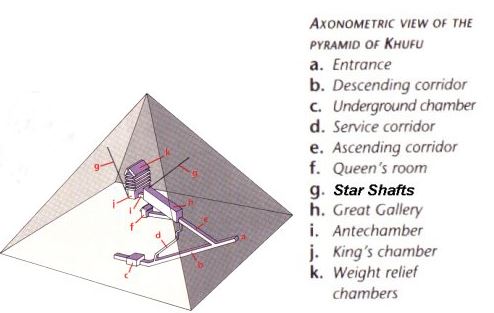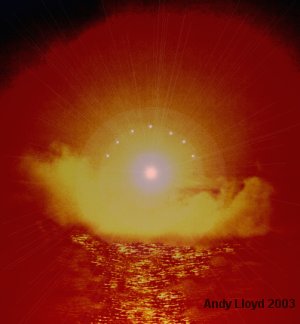
Attaining Immortality
Whilst the onus of this web-site has been about finding physical evidence to explain myth, it remains the case that much of the religious direction of the allegory is spiritual. Indeed, many of those who have an interest in Sitchin’s 12th Planet Theory look upon the concept of Nibiru in spiritual ways, and the Winged Planet has become part of the New Age movement. Furthermore, the ‘meaning’ of the Pagan and Gnostic Mysteries that include the dark star are aimed at attaining enlightenment and spiritual growth.

They also contain a strong affiliation with the concept of reincarnation, in common with the Hindu religion whose early origins in the Vedas seem to owe much to the Sumerian mythology. It is possible that in my scientific regard towards factual evidence, even if speculative, I have somewhat neglected this side of things.
Whilst researching this book, it has dawned on me that another meaning can be ascribed to the cult of Nibiru, in all its ancient forms. That is not to say that Nibiru and its moons don’t have a physical form, but that an additional, and highly relevant, metaphysical element is contained within the Mysteries. In other words, the religious and spiritual quest of the initiates into the Mysteries, and the New Age derivatives now taking form, have a complimentary place alongside the physical existence of Nibiru and the Annunaki.
Consider the Egyptian concept of the after-life passage of the Pharoah to the Duat. I have proposed that this complex religious idea is connected to the perihelion passage of the Nibiruan system through the heavenly Duat. If I am right to describe one of Nibiru’s moons as the home-world of the Annunaki, then this planet is the Heaven of the ancients. Might the Pharoah not be trying to seek a path to Heaven through Astral travel? One might argue that the journey to the Nibiruan system would be physical, that the Pharoah would alight aboard a Shem, and blast off to the Dark Star, but I think this is an unlikely scenario. It seems to me that the Annunaki abandoned the people of Earth to their fate, and ceded dominance of the planet to us after the Flood. But the memory of their heavenly world remained part of the religious thinking of the human peoples struggling to rebuild their shattered world.
When considering these religious ideas, let us suppose that the concept of reincarnation dominated ancient thought. This may not be so across the board, but the evidence supports this general thesis. The Egyptian Pharoahs realised that they would have to wait thousands of years to gain their opportunity for resurrection. Did this mean that they had to remain in a spiritual limbo after death until Nibiru again appeared in the sky? That only then would it be safe for their souls to attempt the astral journey to the home-world of their Annunaki forebears? I suggest that the purpose of this difficult journey in the after-life was to emerge into the spiritual matrix of Heaven, and thus attain the opportunity for reincarnation as a god.
Now, I’m not necessarily saying that I would advocate this religious concept as legitimate, but it does seem to make sense in the context of the Egyptian Book of the Dead, the Pyramid Texts and the Stellar Cult of the Duat. There are also parallels in the Mysteries, and, most remarkably, in Christian thought. But before looking at these ideas more closely, let us review the notion of life-after-death itself.
Near-Death Experiences
Science has rarely involved itself in the search for the meaning of life, sensibly preferring to leave such investigations to the religious establishment. However, a cross-over emerges in the study of the “near-death” experience. It has long been recognised that many people who have clinically died, and were subsequently resuscitated, talk of vivid experiences on the ‘other side’. Scientists have tended to understand this in terms of the brain dealing with the trauma of near-death, but evidence has emerged that points towards something far more profound. Two eminent doctors, Drs Fenwick and Parnia, investigated the experiences of 63 cardiac arrest victims at Southampton General Hospital, and concluded that a number of people had almost certainly had near-death experiences after they were pronounced clinically dead. Dr Parnia summed up their findings:
“These people were having these experiences when we wouldn’t expect them to happen, when the brain shouldn’t be able to sustain lucid processes or allow them to form memories that would last…Essentially, it comes back to the question of whether the mind or consciousness is produced from the brain. If we can prove that the mind is produced by the brain, I don’t think there is anything after we die because essentially we are conscious beings. If, on the contrary, the brain is like an intermediary which manifests the mind, like a television will act as an intermediary to manifest waves in the air into a picture or a sound, we can show that the mind is still there after the brain is dead. And that is what I think these near-death experiences indicate.” (1)
If this idea represents the cutting edge of scientific thought, then it seems that scientists could be moving away from the sceptical model that the mind and the brain are one and the same. It also raises some fundamental questions. Is the cosmic mind, or God, the source for our ‘individual’ minds, and that our bodies simply provide a physical basis for the projection of that consciousness? Does that make the Jungian concept of the ‘collective unconscious’ more likely? What happens to the soul after death? Does it get recycled in an eternal cycle of death and rebirth?
Ancient Beliefs in the After-life
The Buddhists and the Egyptians both produced ancient texts providing advice for the soul encountering the trials of the after-life. These ‘Books of the Dead’ were learned by initiates to aid them in finding the true light after death, and prevent a descent into the hellish realms. “The Tibetan Book of the Dead”, or Bardo Thodol, describes the various stages that the liberated soul moves through, each becoming more difficult to bear, until rebirth is urgently sought (2). It aims to concentrate the mind of the living on their continual preparation for the after-life, with liberation from the cycle of life-and -death as the ultimate goal. Reincarnation is the likely outcome for most human beings who have not attained sufficient spiritual advancement during their life, and preceding past lives.
The ancient Egyptians had access to a similar tome, known as “The Egyptian Book of the Dead”, discovered by the eminent Egyptologist Dr E. Wallis Budge, who later translated it. It encompassed 3,000 years of history, remaining a constant throughout the ever-changing complexity of Egyptian religious thought. The work is essentially a description of ritual to be performed by the soul entering the after-life, and arriving at the Land of the Gods (3). Clearly, ancient religious thought revolved around the idea that the departing soul would enter a spiritual domain where the correct behaviour and ritual were essential as a rite of passage. The aim was to achieve a higher spiritual level, and to co-exist with the gods.

One of the stunning differences between these two Books of the Dead is the disposal of the body. For believers in reincarnation, the body is simply a shell that has been disposed of, and the soul is recommended to depart deeper into the after-life without hesitation by the priest reading the rites over the dead. As such, a quick disposal of the body by cremation, or simply leaving the body on rocks for the vultures, was an apt way of persuading the disembodied soul to leave behind its previous existence.
This is a stark contrast to the ancient Egyptian ritual of mummification. By the same token, the preservation of the body would seem to be a means of dissuading the soul from spiritual departure, at least in the eyes of a Buddhist. This would prevent reincarnation and turn the soul into a preta, or unhappy ghost. The Egyptians oldest concept of the spirit was the ka, which was capable of leaving the body during sleep or when the person was in trance. In this way, some ghosts were the kas of sleeping people, others spirits of the departed. The departed ka required sustenance after death, through offerings of food and drink, and through magic. The earliest Egyptians arranged burial with this belief in mind:
“…The early people buried their dead crouched up in shallow graves with due provision of nourishment and implements. They appear to have believed that the ka remained beside the body until the flesh decayed. Then it either ceased to be or haunted the cemetery. Among primitive peoples much concern was evinced regarding the ghosts of the newly dead.” (4)
As the ancient Egyptian religion evolved, the preservation of the body was increasingly taken to quite extreme lengths, through the ritual of bodily dissection and mummification. Yet, according to their belief system, this process would prevent the departure of the ghost, or ka, into the after-life:
“Pharoah’s body was therefore mummified, so that his soul might continue to exist and be able to return to reanimate the bandage form.” (4)
The ancient Egyptians considered the world to be full of disembodied spirits, and were horrified at the prospect of mummified remains rising from the dead. It seems unlikely, therefore, that the purpose of the mummification was to create future ‘undead’, as this Egyptological text implies. What is more likely is that the mummification process prevented the ka from properly escaping into the after-life, or bardo as the Buddhists would call it, but remain as disembodied spirits within our reality. Scholars consider this early belief ‘primitive’, but, as we have seen, everything about these early civilisations suggests inheritance of culture, rather than linear social evolution.
If the Egyptians inherited this very ancient knowledge of the after-life, then why would they wish to see their Pharoahs turned into pretas? Particularly since the Egyptians considered the Pharoah to be ‘an incarnation of the ruling deity’. This makes no sense at all, until one considers the stellar beliefs in conjunction with the burial rituals. Perhaps the souls needed to wait for something, rather than rushing headlong towards rebirth on the earth. Perhaps the ka of the incarnate deity needed to be helped home after its stint of Kingship on Earth. Let me expand on this point, as the Dark Star’s rare celestial appearance potentially offers us a new insight into these bizarre ancient Egyptian rituals.
The Empty Pyramid
The Great Pyramid was found containing no tomb of a great Pharoah, no mummified remains or religious paraphernalia. The assumption has always been, however, that it served as a tomb for Khufu, the Fourth Dynasty Pharoah who supposedly had this most famous of structures built. But the interior of the Pyramid itself offered no firm evidence to support this. The granite sarcophagus in the King’s chamber was built into the structure, rather than carried in, and the one and only inscription, a quarry mark found referring to Khufu, was probably a forgery by the frustrated 19th Century pyramid explore Colonel Howard Vyse (5).
Hancock points to the Inventory Stela as evidence of the antiquity of the Great Pyramid:
“The Inventory Stela, as it was called, had been discovered at Giza in the nineteenth century by the French archaeologist Auguste Mariette. It was something of a bombshell because its text clearly indicated that both the Great Sphinx and the Great Pyramid (as well as several other structures on the plateau) were already in existence long before Khufu came to the throne. The incription also referred to Isis as the ‘Mistriss of the Pyramid’, implying the the monument had been dedicated to the goddess of magic and not Khufu at all. Finally, there was a strong suggestion that Khufu’s pyramid might have been one of the three subsidiary structures alongside the Great Pyramid’s eastern flank.” (5)

Instead, the tombs of the Pharoahs are less grand structures than the Pyramids at Giza themselves, leading many to speculate that the Great Pyramid was designed as a religious device to aid the Pharoah on his journey to the heavens. The discovery of southern ‘star shafts’ pointing towards Sirius and Orion’s belt at the supposed time of the building of the Great Pyramid has reinforced this idea (6). (The purpose of the northern star shafts is less well understood.
The one from the King’s Chamber has an extraordinary kink at its base, seemingly indicating movement of the object in focus. Its raised angle of 32 degrees and 28 minutes suggests to me that this shaft might mark the aphelion position of Nibiru, representing its actual inclined angle to the ecliptic in the northern skies. The kink then suggests the perceived shift in position in the heavens as Nibiru approaches the planetary solar system on its elliptical path.)
Given that no Pharoah was actually interred in this vast structure, or at least there is no evidence to indicate that one ever was, then perhaps the internal structure of the Great Pyramid was meant to be a receptacle of their kas. The mummification process held the Pharoah’s spiritual body back from its flight into the after-life in order to maintain its presence as a ghost, or preta as the Buddhists would have it. The Great Pyramid then became host to the spiritual bodies of the Pharoahs after death, as they awaited the precise time to commence their astral journey into the Duat. That time being the return of the Nibiru system; Ra Harmakhis, the winged disc.
The star shafts would have no use as an astronomical device as the shafts do not surface in the side of the building. Yet, for the ancient Egyptians, they could have provided the Pharoah’s ka with the means to focus attention upon the Duat during the spirit’s multi-millennial wait. Upon the arrival of Nibiru and its moons, the Pharoah’s spiritual body would then take flight upon its astral journey to the realm of the gods.
Ascension to the Nibiru System
The Journey into the Duat requires the ka to enter space, relating to its descent into the underworld, a location of total darkness with a bright light (the Sun). From there the astral ascension is directed by zodiacal imagery to the fiery dark star, and the ultimate destination of its seventh moon, the ‘Fields of Hetep’ or Heaven. This is where our Western concept of the ‘seventh heaven’ is derived from, I’m sure.

Upon arrival, the disembodied soul must then enter the spiritual Matrix of the god’s world, gaining acceptance through its learned rituals, and thus seeking rebirth as a god! This, I propose, is the ultimate goal of the Egyptian Book of the Dead. That the Pharoah’s soul would seek rebirth as one of the Annunaki, whose life-span is practically immortal compared to our own mortal time-frame.
I am not putting forward this idea as a reflection of my own belief structure, but as an interpretation of the beliefs of the ancient Egyptians, whose enigmatic burial rituals have puzzled generations of scholars.
The missing piece of the jigsaw is the physical appearance of the winged disc in the Duat, the physical manifestation of the realm of the gods. Given that this disc and its wings, or moons, appeared only one year in every 3,400-3,800 years, the opportunity for the Earth-trapped souls to ascend would have been extremely rare, and a method for reunifying the Pharoah’s ka with its heavenly home became necessary. The Necropolis at Giza, and the Great Pyramid in particular, may have been designed with this in mind. How else plot an astral journey to a dark star that stubbornly remains invisible for thousands of years?
Written by Andy Lloyd, 1st November 2001
author of 'The Dark Star' (2005), 'Ezekiel One' (2009), 'The Followers of Horus' (2010) and 'Darker Stars' (2019)
Published by Timeless Voyager Press
References
1) Jonathan Petre “Soul-searching Doctors Find Life After Death” The Sunday Telegraph, 22 October 2000
2) Ed. W. Evans-Wentz “The Tibetan Book of the Dead” Oxford University Press, New York 1960
3) E. Wallis Budge “The Egyptian Book of the Dead: The Complete Papyrus of Ani” Dover 1967
4) Geddes & Grosset “Ancient Egypt: Myth & History” p95, 104 Gresham 1997
5) Graham Hancock “Fingerprints of the Gods: The Evidence of Earth's Lost Civilization” pp320-2 Mandarin 1996
6) Robert Bauval and Adrian Gilbert "The Orion Mystery: Unlocking the secrets of the pyramids" Ch11, Mandarin 1994